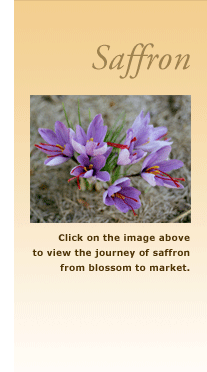|
|
We import the very best quality saffron available from Spain and Greece. Like olive oils or wines, saffrons from different regions of the world have unique flavor and aroma components. The one you prefer is a matter of personal taste, but remember that new crop, properly cultivated and cured saffron from any location will be better than old, dry, or poorly cured and stored saffron. The moment you open a container of Bacstrom saffron, you'll experience the best there is.
Growing regions:
Spanish saffron has long been considered the world's finest. To experience the Spanish tradition of saffron growing, click on the saffron blossoms at left. When I first went to Spain in 1983, it was growing about 70% of the world's crop and large fields of the extraordinarily vibrant lavender crocus could be found across much of the La Mancha Plateau east of Madrid. Today, there are far fewer growers in Spain.
Today, Persian growers in Iran are responsible for the great majority of commercial saffron produced in the world. Because of the extensive labor involved in harvesting saffron and because the cost of labor in Iran is so much less than in Europe, Iran is able to produce a very high quality saffron at favorable prices. There is also a strong Iranian tradition of removing the little yellow "tails" from the stamens by hand, leaving only dark red filaments (see the Sorgol saffron above).
In late September, the U.S. reinstated an embargo on a number of imports from Iran, including saffron. It is difficult to predict how long this will be in effect. We will not be able to import Persian Saffron until this trade embargo is lifted.
In Greece, we are working with the Kozanis Cooperative, representing over 1,200 growers. This is very strong saffron in terms of coloring strength, and it tends to maintain that strength well over time. The flavor profiles have a good complexity, and is more similar to the Spanish than the Persian. The aroma is milder than Mancha Saffron. In addition to the Greek saffron that I am offering in large bulk containers, I have a line of certified organic in retail containers under the Kozanis Cooperative label.
We are continuing to expand our interest in high quality saffron from Morocco, Kashmir, Afghanistan, and Italy. When I find a good dependable sources, I will likely add these options to my offerings.
Methods of Use:
The most common error made by those not familiar with using saffron is to add saffron threads directly to their cooking food, resulting in a few blotches of yellow and little flavor. But simply by first infusing the saffron in liquid for a minimum of forty minutes, you will get the full flavor, color and aroma that are unique to saffron. Simply pour hot water or stock over the threads and let them "steep" as you would a cup of tea. This process can be advanced by first grinding the saffron in a mortar and pestle along with a few sugar or salt crystals for resistance, then adding the warm liquid. Alternatively, one can place the warm liquid and saffron threads in a blender, which will sufficiently break up the saffron and speed up the infusing process. Some people recommend "toasting" the saffron first either in the oven or in a skillet and then crushing the threads with the back of a spoon or in a mortar and pestle. This has advantages in terms of aroma, but there is the strong possibility of burning the threads and rendering them useless. Once the saffron has been infused in the liquid of choice, it is ready to use. Saffron-infused liquids may be refrigerated for several weeks.
Powdered Saffron:
The advantage of using powdered saffron is that it does not need to go through the infusing process before using, and it is slightly easier to measure. As with most spices, however, saffron in its "whole" form retains its potency longer than the powdered form. For this reason, we do the grinding here in our facility. This not only insures its maximum freshness, but also adds the certainty of knowing exactly what quality of saffron is being used, something more difficult to tell once it is in the powdered form.
Storage:
Saffron likes to be stored in a cool dark place, though not refrigerated. It prefers an airtight container and a fairly constant temperature between 40 and 60 degrees C. In lieu of that, the lower shelf of a dark cabinet will suffice. Use up threads within three years and powdered saffron within a year, though don't throw out older saffron, as it will still retain some coloring strength and some flavor, though very little of its original aroma.
About Coloring Power:
The best qualities of saffron from each region will have the greatest coloring power shortly after harvest, generally 220 to 260 units of coloring power. The ISO (International Organization for Standardization) sets the minimum coloring strength for Category I saffron to be 190 units, Category II at 150 units, Category III at 110 units. Category I saffron has the potential to color up to 10,000 times its own volume a strong shade of yellow. All of our saffron is Category I and when the new crop saffron is shipped to us, it generally rates between 220 and 260 units and will begin to lose its strength over time. Some saffron tends to retain its coloring strength longer than others.
|
|





